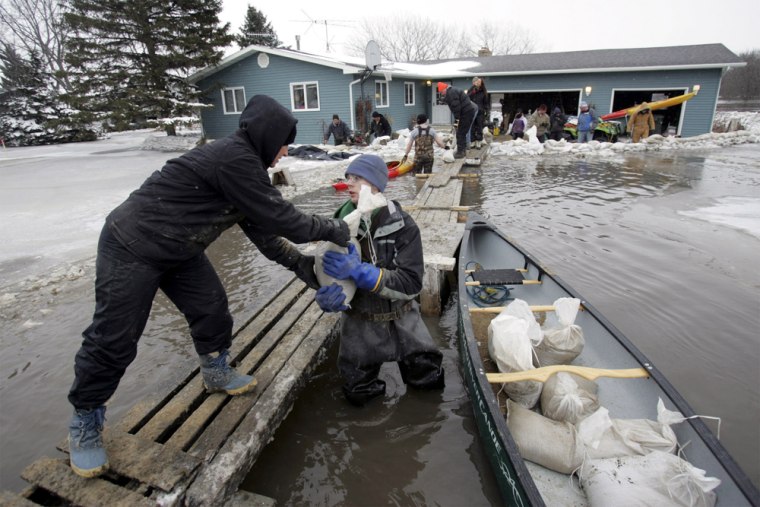Having avoided disaster during the flood of 1997, Fargo may be a victim of its own success.
After Fargo officials undertook extra flood precautions and avoided disaster, the Army Corps of Engineers turned its attention to Grand Forks, which was not so lucky, building a comprehensive $400 million flood protection system for the city.
Today, as floodwaters threaten to drown Fargo, Grand Forks is relatively calm and not worried that it will see the devastation it endured 12 years ago. Its protection includes some 30 miles of levees, two miles of flood walls, 22 pump stations and 10 miles of diversion channels.
"In 1997 we won, we beat the flood, in every community but Grand Forks," said Sen. Kent Conrad, D-N.D. "So of course there was a tremendous focus on building longer-term defenses for the city. Fargo won the flood fight, so naturally there was less pressure to deal with a more far reaching, long-term solution."
With his city facing a potential disaster, Fargo Mayor Dennis Walaker says, "I hope that isn't what it takes to get somebody to agree that for us that's what's needed."
Some members of the state's congressional delegation now believe that a more holistic approach to flood protection is needed in the notoriously flood-prone Red River Valley.
"These are inevitable threats to North Dakota's most significant, most populous cities, and proper protections need to be built," said Rep. Earl Pomeroy, D-N.D.
Pomeroy, Conrad and Sen. Byron Dorgan, D-N.D., met with President Barack Obama on Wednesday to talk about the flooding.
Two lawmakers from neighboring Minnesota, Rep. Collin Peterson and Sen. Amy Klobuchar, both Democrats, also are pushing the White House for disaster relief.
No 'big push' in Fargo
Aaron Snyder, the Army Corps of Engineers' project manager for the Red River basin, said there is no technical reason for the difference in protection. He attributed it to impetus at the local level and in Congress.
Fargo's metropolitan area has recently begun the process of a comprehensive review by the Corps, but it did not feel the same pressure after 1997.
"What you see a lot of times is there's much more support following a catastrophe," Snyder said. "You see a big push. Since Fargo's been very successful in the past, there hasn't been as big of a push."
Fargo has been asking for state and federal help for a $161 million dike project. And Snyder said Fargo had made an effort to improve its flood protections since 1997, but he added: "It's just not of the magnitude of what was done in Grand Forks."
Fargo property owners and government officials alike have applied lessons from past floods to fighting this one — whether it's smarter ways to hold back water, or just taking better care of your body after a long day hoisting heavy sandbags.
City administrator Pat Zavoral said the city would be in even worse shape if not for post-1997 improvements. "A lot of the people running things worked here then, and we have pretty good institutional knowledge of fighting floods," said Zavoral, who was the city's public works director in 1997.
Fighting the freeze
One example: In 1997, a water pump next to the levee that protects Fargo's Shriners Center from the river froze up and failed. Employees noticed the rising water just inches before it spilled into the basement and scrambled to pump it out.
"Not this time," said Ken Maxson, the chapter's recorder, minutes after he rigged up a crude incubator for keeping the water in the pump above 32 degrees: dropping a light bulb inside and covering it with a tarp. "It might not seem like a huge thing, but this could be the difference between dry and wet for our building."
Zavoral cited other changes:
- Most dikes were raised. In 1997, dikes protected the city from the river up to 31 feet above flood stage, where now they go up to 38 feet above flood stage.
- The city doubled from one to two the number of sites where sandbags are assembled and also set up mini-sandbag stations at strategic spots in some neighborhoods.
- Fargo removed some houses from harm's way altogether, purchasing and moving about 100 out of the flood plain since 1997.
- Technological gains have also focused protection efforts, with geographic computer mapping of the extremely flat city indicating what Zavoral called "subtle nuances in elevation" that help with decisions about where to strategically place temporary dikes.
Tim Mahoney, a Fargo city commissioner and a doctor, added that Fargo is being more diligent this time around about making sure no city workers or volunteers work for too long without a break.
"If you're too tired, you're useless," he said. To that end, the North Dakota National Guard has deployed about three times as many National Guard soldiers to work on sandbag lines than compared to a dozen years ago.
Fighting geography
Flooding is a constant threat for every city in the Red River Valley, where geography works against the population base. The river flows south to north along the flat North Dakota countryside.
"Most Americans don't understand it's as flat as a table top. It's not a channel of water. When it floods it just spreads all over," said Dorgan. "It's unlike most flooding any American would ever see."
Conrad said Fargo's newest struggles have convinced him that a broader view might be appropriate.
"As we go through this incident and review what's occurred, it may well be that a determination will be made to have a much more extensive flood defense system than we previously thought was necessary," he said.
